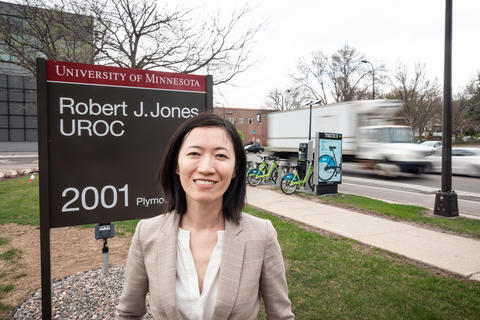
Rethinking Transportation

Once just an idea, autonomous (self-driving) vehicles are now on the verge of becoming a real part of our transportation system. Just how these new vehicles will reshape the way we get around is not yet known. But researchers around the country are busy studying how transportation services of the future can be rethought and redesigned to better benefit cities and communities everywhere.
At the University of Minnesota’s Humphrey School of Public Affairs, professor Yingling Fan, a UROC resident researcher, and research fellow Frank Douma have launched a three-year study to investigate how shared autonomous vehicles may benefit the most challenged communities. Their work is one of the core components of a $1.75 million grant from the National Science Foundation entitled Leveraging Shared Autonomous Vehicles for Greater Community Health, Equity, Livability, and Prosperity (HELP).
The grant is being led by computer science and engineering professor Zhi-Li-Zhang and centers around a “smart cloud commuting system” that would allow Northside residents to share autonomous vehicles, including cars, vans, shuttles, and buses.
Such a reimagined system could lead to fewer cars on the road, eliminating the need for many parking lots and ramps. Eventually, streets and highways could be redesigned to include fewer driving lanes and more green space. It could also offer people living in North Minneapolis, and other economically disadvantaged communities, better access to reliable, affordable public transportation.
Working with the Northside Job Creation Team at UROC, Fan has done extensive research on the difficulties some urban workers face when trying to commute to jobs that are often in the suburbs. What she found reinforced her belief that existing services are not equitable.
“Transportation options on the Northside are not good compared to other parts of Minneapolis, and that reinforces economic segregation,” she says, explaining that while North Minneapolis has the highest concentration of low-income residents, most of the available jobs are in the Southwest suburbs. “We have done a lot of work confirming that Northside residents face greater transportation barriers when trying to access job opportunities, and that’s not sufficient.”
As part of the study, Fan and the other researchers on multiple teams will be looking at ways sharing autonomous vehicles could benefit Northside residents and how such a system might mitigate transportation inequity. In addition to considering questions like, how much the system would cost and what kind of technology might be needed to use it, the researchers are being mindful of how this type of transportation change could impact communities.
“Equity is often not the first thing that engineers consider when designing systems,” Fan says. “The help I got from the Northside Job Creation Team was so important because we are thinking about more than people’s experiences using a new transportation system. We want people to have a voice in how shared self-driving vehicles could affect their community, and UROC was able to connect us to neighbors and other insiders who are active on the Northside. They also shared my work and have used it as part of some of their own research, which made it more impactful for all of us.”